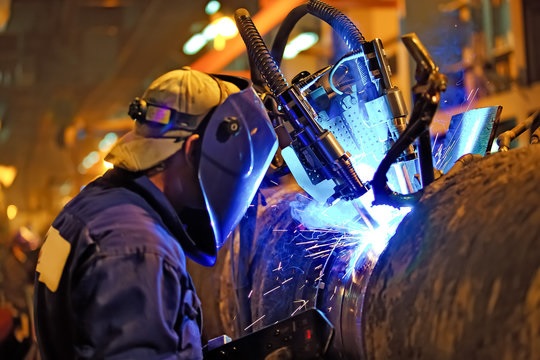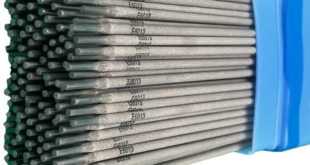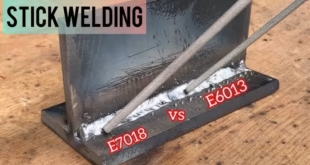The Welding Materials and their Properties
Introduction
Definition of welding:
Welding is a process of joining two or more pieces of metal or thermoplastics by heating them to their melting point and allowing them to fuse together.
Importance of welding materials and their properties:
Welding is an essential process in many industries, including construction, manufacturing, and repair. The quality and durability of a welded joint depend on the type of welding material used and its properties. Understanding the characteristics of different welding materials is crucial in selecting the right material for a particular application and ensuring that the welded joint meets the necessary performance requirements. In this paper, we will discuss the various welding materials and their properties to provide a comprehensive understanding of this essential aspect of welding.

Types of welding materials
Ferrous metals
- Carbon steels: Carbon steels are the most common type of ferrous metal used in welding. They are relatively inexpensive and offer good strength and toughness. Carbon steels can be further classified into low carbon steels, medium carbon steels, and high carbon steels, depending on their carbon content.
- Alloy steels: Alloy steels are a type of ferrous metal that contains additional alloying elements, such as chromium, nickel, or molybdenum, to enhance their properties. Alloy steels offer improved strength, hardness, and corrosion resistance compared to carbon steels.
- Stainless steels: Stainless steels are a type of alloy steel that contains at least 10.5% chromium, which provides excellent corrosion resistance. Stainless steels are commonly used in applications where resistance to corrosion and staining is critical, such as in the food and beverage industry and in medical equipment.
Non-ferrous metals
- Aluminum: Aluminum is a lightweight and corrosion-resistant metal that is commonly used in the aerospace, automotive, and construction industries. Aluminum alloys can be easily welded using several different welding techniques, including MIG, TIG, and resistance welding.
- Copper: Copper is an excellent conductor of heat and electricity and is commonly used in electrical applications, such as in wiring and motors. Copper can be welded using several different welding techniques, including oxyacetylene, resistance, and TIG welding.
- Titanium: Titanium is a lightweight and strong metal that is commonly used in aerospace, military, and medical applications. Welding titanium requires special techniques, such as using a high-purity inert gas to prevent contamination and using specialized welding equipment. 4. Magnesium: Magnesium is a lightweight and strong metal that is commonly used in the aerospace and automotive industries. Welding magnesium requires special techniques, such as using a high-purity inert gas to prevent oxidation and using specialized welding equipment.
Properties of welding materials
Mechanical properties
- Tensile strength: Tensile strength is the maximum stress that a material can withstand before it breaks or fails. The tensile strength of a welding material is an essential property to consider when selecting a material for a particular application.
- Ductility: Ductility is the ability of a material to deform under stress without breaking. Materials with high ductility can be deformed significantly without cracking or breaking, making them easier to weld.
- Hardness: Hardness is the resistance of a material to indentation or scratching. The hardness of a welding material is an essential property to consider when selecting a material for applications where resistance to wear and abrasion is critical.
Chemical properties
- Corrosion resistance: Corrosion resistance is the ability of a material to resist degradation due to chemical reactions with the environment. The corrosion resistance of a welding material is an essential property to consider when selecting a material for applications where exposure to corrosive environments is likely.
- Oxidation resistance: Oxidation resistance is the ability of a material to resist degradation due to reactions with oxygen. The oxidation resistance of a welding material is an essential property to consider when selecting a material for applications where exposure to high temperatures and oxygen is likely.
- Weldability: Weldability is the ease with which a material can be welded without defects. The weldability of a welding material depends on several factors, including its chemical composition, melting point, and thermal conductivity.
Physical properties
- Melting point: The melting point is the temperature at which a material transitions from a solid to a liquid state. The melting point of a welding material is an essential property to consider when selecting a material for welding because it affects the welding process and the properties of the welded joint.
- Thermal conductivity: Thermal conductivity is the ability of a material to conduct heat. The thermal conductivity of a welding material is an essential property to consider when selecting a material for applications where heat dissipation is critical.
- Electrical conductivity: Electrical conductivity is the ability of a material to conduct electricity. The electrical conductivity of a welding material is an essential property to consider when selecting a material for applications where electrical conductivity is critical.
Selection of welding materials
Factors to consider
Joint configuration: The joint configuration, including the type of joint and the thickness of the materials being joined, can affect the selection of welding materials. Some welding processes and materials are better suited for certain joint configurations than others.
Service conditions: The service conditions, including temperature, corrosion, and mechanical stress, can affect the selection of welding materials. Materials that are more resistant to corrosion, high temperatures, or mechanical stress may be necessary for some applications.
Cost: The cost of the welding materials can also be a significant factor in their selection, especially for large-scale or high-volume welding applications.
Matching welding materials to base materials:
Welding materials should be selected to match the base materials being joined. Matching the welding materials to the base materials can help ensure that the welded joint has the necessary properties and meets the required specifications.
Welding material substitutions:
Substituting one welding material for another may be necessary in some cases, such as when the original material is not available or is too expensive. However, substituting materials can affect the properties of the welded joint and should be done with caution. It is essential to evaluate the properties of the substituted material carefully and consider any potential changes to the welding process.
FAQs
What are the properties of welding materials?
Welding materials have different properties, including mechanical properties (such as tensile strength, ductility, and hardness), chemical properties (such as corrosion and oxidation resistance), and physical properties (such as melting point, thermal conductivity, and electrical conductivity).
What is the material of welding?
The material used for welding can vary depending on the application and the type of welding process being used. Common welding materials include various metals, alloys, and filler materials.
How many types of welding materials are there?
There are many types of welding materials, but they can generally be classified as either ferrous or non-ferrous metals. Ferrous metals include carbon steel, alloy steel, and stainless steel, while non-ferrous metals include aluminum, copper, titanium, and magnesium.
What are the 7 basic weldings? The seven basic types of welding are:
- Gas metal arc welding (GMAW)
- Gas tungsten arc welding (GTAW)
- Shielded metal arc welding (SMAW)
- Flux-cored arc welding (FCAW)
- Submerged arc welding (SAW)
- Electroslag welding (ESW)
- Electron beam welding (EBW)
What are the five properties of metal materials?
Some common properties of metal materials include high strength, ductility, malleability, good thermal conductivity, and good electrical conductivity.
What are the physical properties of materials?
Physical properties of materials refer to characteristics that can be observed or measured without changing the substance’s chemical composition. Examples of physical properties include density, melting point, boiling point, and electrical conductivity.
What iron material for welding?
Iron can be welded using various welding processes, including shielded metal arc welding (SMAW), gas tungsten arc welding (GTAW), and gas metal arc welding (GMAW). The specific welding material used will depend on the type of iron being welded and the desired properties of the welded joint.
What material is used for iron welding?
The material used for iron welding can vary depending on the type of iron being welded and the welding process used. Common welding materials for iron include mild steel, stainless steel, and cast iron.
What are the 10 material properties? The ten common material properties include:
- Density
- Strength
- Hardness
- Toughness
- Ductility
- Brittleness
- Elasticity
- Plasticity
- Conductivity
- Thermal expansion
What material is a welding rod?
Welding rods are made of various materials, including mild steel, stainless steel, and aluminum. They are used to provide filler material for welding joints and are selected based on the type of welding process being used and the properties required for the welded joint.
Which gas is used in welding?
The type of gas used in welding depends on the welding process being used. For example, shielding gases like argon and helium are used in gas tungsten arc welding (GTAW), while gases like carbon dioxide and argon are used in gas metal arc welding (GMAW).
What alloy is used in welding?
Different alloys can be used in welding, depending on the materials being joined and the desired properties of the welded joint. Common alloys used in welding include stainless steel alloys, aluminum alloys, and nickel-based alloys.
Conclusion
Recap of main points:
In summary, welding materials are crucial components in the welding process, and their properties play a significant role in the success and quality of the welded joint. The mechanical, chemical, and physical properties of welding materials should be carefully evaluated when selecting materials for specific applications.
Future of welding materials and their properties:
The future of welding materials is focused on developing new materials that offer improved properties, such as increased strength, durability, and corrosion resistance. Advancements in technology are also driving the development of new welding processes that can join dissimilar materials, making it possible to create materials with a combination of desirable properties. As the demand for more complex and sophisticated applications increases, the development of new welding materials and processes will continue to play a critical role in meeting the evolving needs of the industry.
 Welding of Welders All about Welding and Welders
Welding of Welders All about Welding and Welders



